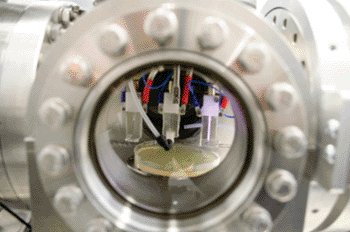Scientists Unravel Antibacterial Mechanisms of Plasma Components
By LabMedica International staff writers
Posted on 10 Oct 2013
Scientists have unraveled the main mechanisms of the antibacterial action of cold atmospheric-pressure plasmas, further indicating their potential value as disinfection and antibiotic agents.Posted on 10 Oct 2013
As they destroy bacteria very efficiently, atmospheric-pressure plasmas constitute an alternative to chemical disinfectants and are already being used as surgical tools, for example in nasal and intestinal polyp extraction. Their disinfectant properties may also be of interest for other applications, including wound treatment, cosmetic care, and in certain uses even as alternatives to antibiotics. “In ten years, bacteria might have developed resistance against all antibiotics that are available to us today,” said Junior Professor Dr. Julia Bandow, head of the Junior Research Group Microbial Antibiotic Research at Ruhr-Universität Bochum (Ruhr University Bochum (RUB); Bochum, Germany). Without antibiotics, most surgeries would become impossible due to high infection rates.

Image: Plasma Reactor – cold atmospheric-pressure plasmas are generated and tested for effects on bacterial cells and molecules (Photo courtesy of Jan-Wilm Lackmann, Ruhr University Bochum.)
Cold atmospheric-pressure plasmas attack the prokaryote cell envelope, proteins, and DNA. “This is too great a challenge for the repair mechanisms and the stress response systems of bacteria,” said Prof. Bandow; “In order to develop plasmas for specific applications, for example for treating chronic wounds or for root canal disinfection, it is important to understand how they affect cells. Thus, undesirable side effects may be avoided right from the start.”
Effects of the plasma-emitted particles have now been investigated by a team of biologists, plasma physicists, and chemists at RUB. Depending on their specific composition, plasmas may contain different components, for example ions, radicals, or light in the ultraviolet spectrum—UV photons. Until now, scientists have had almost no understanding about which components of the complex mixture contribute to which extent to the antibacterial effect. Prof. Bandow’s team has analyzed the effect of reactive particles (radicals and ozone) and UV photons on both the cellular level and on the level of single biomolecules, namely DNA and proteins. On the cellular level, the reactive particles alone were most effective: they destroyed the cell envelope (UV radiation did not). On the molecular level, both plasma components were effective: both UV radiation and reactive particles damaged the DNA; in addition, the reactive particles inactivated proteins. Thus, damage to the cellular envelope as well as to DNA and proteins contribute to the bactericidal properties of cold atmospheric-pressure plasma.
The study was published September 25, 2013, in the Journal of the Royal Society Interface.
Related Links:
Ruhr University Bochum














